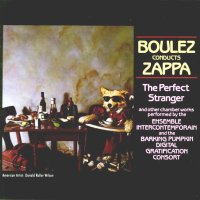
Again, Zappa's talent for finding new and previously unheard voicings among the standard orchestral instruments is well evidenced here.
His eclectic, Stravinskian compositional style seems particularly well suited to chamber orchestra; more to the point, his works have never been conducted by a conductor of Boulez's stature and acumen.
The latter's legendary attention to detail finds a worthy foil in Zappa's demanding scores.
Zappa's orchestral pieces, like Strauss's tone poems, tend to the extremely programmatic.
As his notes to these seven "dance pieces" hint, and listening confirms, he graphically indicates ringing doorbells, raised eyebrows, vacuum cleaners, and "an elderly Republican couple trying to make love while break-dancing."
Though this often reduces his music, particularly the title piece, to the level of a well-made cartoon, there is still plenty of musical information to repay repeated listenings.
"Naval Aviation in Art," a tense, foreboding vignette, receives a much better reading here than on 1979's ill-fated, entirely uncredited Orchestral Favorites LP.
It is also a rare instance of a Zappa composition in which there are very few notes, and all the more striking for that.
This is an area I'd love to see him explore further.
"Dupree's Paradise" owes much, again, to Stravinsky's works for small orchestra, particularly his Symphony in C.
Depicting in early-20th-Century musical language a jam session in a Watts bar in 1964, it is fresh, acerbic, funny, and sharp. I particularly enjoy the double piano passage soon after the beginning.
The remaining four synclavier pieces function as a primer in the use of that remarkable instrument, and as the rough draft for last year's Jazz From Hell.
Listen carefully to the album's finale, "Jonestown," a terrifying tonepoem in which Jim Jones is musically depicted banging a child's skull against the side of a steel vat full of poison, droning "Come and get it!" in nightmarish slow motion.
The nth chapter in Zappa's crusade against organized religion, and the most effective.
The sound is virtually identical in black and silver formats, with the LP sounding just a hair more lush in resonance and bass.
Both are highly recommended.
-Richard (Utility Muffin) Lehnert Vol.10 No.8 November, 1987
If you, by some bizarre mishap ended up here via search engine,
CLICK HERE
and it will all make sense.